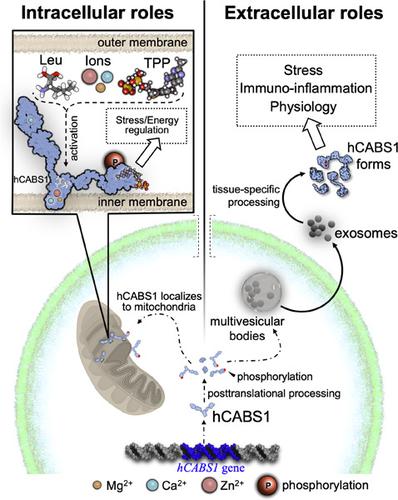当前位置:
X-MOL 学术
›
J. Cell. Biochem.
›
论文详情
Our official English website, www.x-mol.net, welcomes your
feedback! (Note: you will need to create a separate account there.)
Structural and posttranslational analysis of human calcium-binding protein, spermatid-associated 1.
Journal of Cellular Biochemistry ( IF 3.0 ) Pub Date : 2020-07-21 , DOI: 10.1002/jcb.29824 Marcelo Marcet-Palacios 1, 2 , Eduardo Reyes-Serratos 1 , Aron Gonshor 3 , Robert Buck 3, 4 , Paige Lacy 1 , A D Befus 1
Journal of Cellular Biochemistry ( IF 3.0 ) Pub Date : 2020-07-21 , DOI: 10.1002/jcb.29824 Marcelo Marcet-Palacios 1, 2 , Eduardo Reyes-Serratos 1 , Aron Gonshor 3 , Robert Buck 3, 4 , Paige Lacy 1 , A D Befus 1
Affiliation

|
Recently, we detected a novel biomarker in human saliva called calcium‐binding protein, spermatid‐associated 1 (CABS1). CABS1 protein had previously been described only in testis, and little was known of its characteristics other than it was considered a structurally disordered protein. Levels of human CABS1 (hCABS1) in saliva correlate with stress, whereas smaller sized forms of hCABS1 in saliva are associated with resilience to stress. Interestingly, hCABS1 also has an anti‐inflammatory peptide sequence near its carboxyl terminus, similar to that of a rat prohormone, submandibular rat 1. We performed phylogenetic and sequence analysis of hCABS1. We found that from 72 CABS1 sequences currently annotated in the National Center for Biotechnology Information protein database, only 14 contain the anti‐inflammatory domain “TxIFELL,” all of which are primates. We performed structural unfoldability analysis using PONDER and FoldIndex and discovered three domains that are highly disordered. Predictions of three‐dimensional structure of hCABS1 using RaptorX, IonCom, and I‐TASSER software agreed with these findings. Predicted neutrophil elastase cleavage density also correlated with hCABS1 regions of high structural disorder. Ligand binding prediction identified Ca2+, Mg2+, Zn2+, leucine, and thiamine pyrophosphate, a pattern observed in enzymes associated with energy metabolism and mitochondrial localization. These new observations on hCABS1 raise intriguing questions about the interconnection between the autonomic nervous system, stress, and the immune system. However, the precise molecular mechanisms involved in the complex biology of hCABS1 remain unclear. We provide a detailed in silico analysis of relevant aspects of the structure and function of hCABS1 and postulate extracellular and intracellular roles.
中文翻译:

人类钙结合蛋白(精子细胞相关蛋白 1)的结构和翻译后分析。
最近,我们在人类唾液中检测到一种新型生物标志物,称为钙结合蛋白、精子细胞相关 1 (CABS1)。此前,CABS1 蛋白仅在睾丸中被描述,除了被认为是一种结构无序的蛋白外,对其特性知之甚少。唾液中人类 CABS1 (hCABS1) 的水平与压力相关,而唾液中较小形式的 hCABS1 与压力恢复能力相关。有趣的是,hCABS1 在其羧基末端附近也有一个抗炎肽序列,类似于大鼠激素原,下颌下大鼠 1。我们对 hCABS1 进行了系统发育和序列分析。我们发现,在国家生物技术信息中心蛋白质数据库目前注释的 72 个 CABS1 序列中,只有 14 个含有抗炎结构域“TxIFELL”,所有这些序列都是灵长类动物。我们使用 PONDER 和 FoldIndex 进行结构可折叠性分析,发现了三个高度无序的域。使用 RaptorX、IonCom 和 I-TASSER 软件对 hCABS1 三维结构的预测与这些发现一致。预测的中性粒细胞弹性蛋白酶裂解密度也与高度结构紊乱的 hCABS1 区域相关。配体结合预测鉴定出 Ca 2+、Mg 2+、Zn 2+、亮氨酸和焦磷酸硫胺素,这是在与能量代谢和线粒体定位相关的酶中观察到的模式。这些关于 hCABS1 的新观察结果提出了关于自主神经系统、压力和免疫系统之间相互联系的有趣问题。然而,hCABS1 复杂生物学中涉及的精确分子机制仍不清楚。我们对 hCABS1 的结构和功能的相关方面进行了详细的计算机分析,并假设了细胞外和细胞内的作用。
更新日期:2020-07-21
中文翻译:

人类钙结合蛋白(精子细胞相关蛋白 1)的结构和翻译后分析。
最近,我们在人类唾液中检测到一种新型生物标志物,称为钙结合蛋白、精子细胞相关 1 (CABS1)。此前,CABS1 蛋白仅在睾丸中被描述,除了被认为是一种结构无序的蛋白外,对其特性知之甚少。唾液中人类 CABS1 (hCABS1) 的水平与压力相关,而唾液中较小形式的 hCABS1 与压力恢复能力相关。有趣的是,hCABS1 在其羧基末端附近也有一个抗炎肽序列,类似于大鼠激素原,下颌下大鼠 1。我们对 hCABS1 进行了系统发育和序列分析。我们发现,在国家生物技术信息中心蛋白质数据库目前注释的 72 个 CABS1 序列中,只有 14 个含有抗炎结构域“TxIFELL”,所有这些序列都是灵长类动物。我们使用 PONDER 和 FoldIndex 进行结构可折叠性分析,发现了三个高度无序的域。使用 RaptorX、IonCom 和 I-TASSER 软件对 hCABS1 三维结构的预测与这些发现一致。预测的中性粒细胞弹性蛋白酶裂解密度也与高度结构紊乱的 hCABS1 区域相关。配体结合预测鉴定出 Ca 2+、Mg 2+、Zn 2+、亮氨酸和焦磷酸硫胺素,这是在与能量代谢和线粒体定位相关的酶中观察到的模式。这些关于 hCABS1 的新观察结果提出了关于自主神经系统、压力和免疫系统之间相互联系的有趣问题。然而,hCABS1 复杂生物学中涉及的精确分子机制仍不清楚。我们对 hCABS1 的结构和功能的相关方面进行了详细的计算机分析,并假设了细胞外和细胞内的作用。











































 京公网安备 11010802027423号
京公网安备 11010802027423号